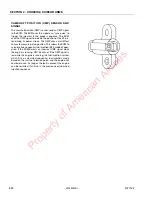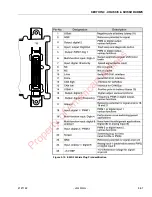
SECTION 3 - CHASSIS & SCISSOR ARMS
3121133
– JLG Sizzor –
3-37
The ECM is designed to maintain exhaust emission levels
to government mandated standards while providing excel-
lent operation and fuel efficiency. The ECM monitors
numerous engine functions via electronic sensors such as
the throttle position (TP) sensor and the heated oxygen
sensor (HO2S).
ECM INPUTS/OUTPUTS
Inputs—Operating Conditions
• Engine Coolant Temperature
• Crankshaft Position
• Exhaust Oxygen Content
• Manifold Absolute Pressure
• Battery Voltage
• Throttle Position
• Fuel Pump Voltage
• Intake Air Temperature
• Camshaft Position
Outputs - System Controlled
• Fuel Control
• Idle Air Control
• Electric Fuel Pump
• Diagnostics:
- Malfunction Indicator Lamp
- Data Link Connector (DLC)
ECM SERVICE PRECAUTIONS
The ECM is designed to withstand normal current draws
associated with engine operation. When servicing the
ECM, observe the following guidelines:
• Do not overload any circuit.
• Do not probe wires for testing. This can cause a volt-
age drop that would be critical to the operation of the
ECM.
• When testing for opens and shorts, do not ground or
apply voltage to any of the ECM's circuits unless
instructed to do so.
• When measuring voltages, use only a digital voltmeter
with an input impedance of at least 10 megohms.
• Do not jump start with more than 12 volts. This could
cause damage to the electronic components.
• Do not employ any non-standard practices such as
charging the battery with an arc welder.
• Take proper precautions to avoid static damage to the
ECM. Refer to "Electrostatic Discharge Damage" for
more information.
THROTTLE POSITION (TP) SENSOR
The throttle position (TP) sensor is a potentiometer con-
nected to the throttle shaft on the throttle body which is
built into the electronic governor. The ECM monitors the
voltage on the signal line and calculates throttle position.
As the throttle valve angle is changed, the TP sensor sig-
nal also changes. At a closed throttle position, the output
of the TP sensor is low. As the throttle valve opens, the
output increases so that at wide open throttle (WOT), the
output voltage should be above 4 volts.
The ECM calculates fuel delivery based on throttle valve
angle (operator demand). A broken or loose TP sensor
may cause intermittent bursts of fuel from an injector and
unstable idle because the ECM thinks the throttle is mov-
ing. A hard failure in the TP sensor 5-Volt reference or sig-
nal circuits for greater than 2 consecutive seconds will set
either a DTC 12 or DTC 22. A hard failure with the TP sen-
sor ground circuit for more than two consecutive seconds
may set DTC 22. If either DTC 12 or DTC 22 are set, the
throttle will be forced to a 6% (idle) position.
USE OF CIRCUIT TESTING TOOLS
Do not use a test light to diagnose the engine electrical
systems unless specifically instructed by the diagnostic
procedures. A test light can put an excessive load on an
ECM circuit and result in component damage. For volt-
age measurements, use only a digital voltmeter with an
input impedance of at least 10 megohms.
Property of American Airlines
Содержание 3394RT
Страница 2: ...P r o p e r t y o f A m e r i c a n A i r l i n e s...
Страница 26: ...SECTION 1 SPECIFICATIONS 1 16 JLG Sizzor 3121133 NOTES P r o p e r t y o f A m e r i c a n A i r l i n e s...
Страница 124: ...SECTION 3 CHASSIS SCISSOR ARMS 3 88 JLG Sizzor 3121133 NOTES P r o p e r t y o f A m e r i c a n A i r l i n e s...
Страница 178: ...SECTION 5 JLG CONTROL SYSTEM 5 24 JLG Lift 3121133 NOTES P r o p e r t y o f A m e r i c a n A i r l i n e s...
Страница 227: ...P r o p e r t y o f A m e r i c a n A i r l i n e s...



































